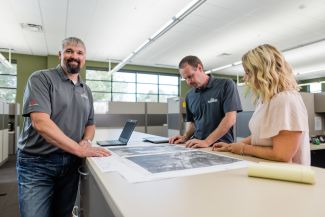Five Steps For Efficient Emergency Egress Lighting in Commercial Buildings
- January 30, 2024
- Best Practices
- Lighting

How to Plan for Emergency Lighting in your Next Project
While we never want to depend on emergency lighting, it’s necessary for keeping our public spaces safe when the power goes out. Planning an effective emergency egress lighting system that meets egress lighting requirements is tricky though. What electrical lighting standards should you follow? How much light do you need under normal and emergency conditions? Are emergency lights required in every room? To help you out, here are five steps you can take to ensure an effective emergency egress lighting system on your next project.
1. RESEARCH YOUR ELECTRICAL LIGHTING STANDARDS
Before you begin, do you know the emergency egress lighting requirements in your area? With different electrical lighting standards, building codes and city and state regulations, it can be complicated. You will want to check with the Authority Having Jurisdiction (AHJ) in your state or jurisdiction. It could be a city employee, electrical inspector or state inspector depending on your location.
Typically, checking the NFPA101 emergency lighting requirements (Life Safety Code) is a good place to start. After that, the building code will have a few more regulations, your state will have standards and the city inspector will have their opinion. It’s not a straightforward process, but the AHJ has the ultimate say.
2. IDENTIFY THE PATH OF EGRESS (PLUS YOUR EMERGENCY LIGHTS FOR RESTROOMS AND ELECTRICAL ROOMS)
Simply put, the path of egress is how you get out of the building in an emergency. In practice, it’s a little more complicated than that. Normally, a corridor or an interior space with two doors is considered a path of egress—think of a big conference room or cafeteria—whereas an office with just one door going into the corridor is not considered a path of egress.
Not all rooms are created equal though. Are emergency lights required in restrooms? Even though most restrooms only have one door (like an office), emergency light requirements in restrooms depend on the square footage of the room. Any public restroom over 300 square feet is required to have an egress light.
3. KNOW HOW MANY FOOT CANDLES FOR EMERGENCY LIGHTING ARE REQUIRED
Once you have determined the path of egress, do you know how many foot candles for emergency lighting you need in those areas?
Under emergency conditions, the path of egress must be illuminated to an average of one foot-candle (1 fc) with a minimum of 0.1 fc. After power is lost, the emergency lighting must turn on within 10 seconds and stay on for at least 90 minutes. Over those 90 minutes, the average light levels can degrade by up to 40% and drop to as low as 0.6 fc.
In addition to required foot-candle levels, your light uniformity cannot exceed 40:1. For example, if you measure 40 foot-candles directly under a fixture, the lowest point between that fixture and the next fixture cannot drop below 1 fc. The purpose is to even out the light distribution to reduce glare and minimize how much our eyes must adjust to varying light levels.
4. CHOOSE AN EFFICIENT WAY TO POWER YOUR EMERGENCY EGRESS LIGHTING
Emergency egress lighting needs to work when you lose power, so what is the best way to power the emergency lights? It depends on where you are installing them. Using standalone fixtures that can be mounted to a wall or ceiling with batteries in the unit is the most common way to power emergency egress lighting. Standalone units require more maintenance though because someone must address each fixture individually. Emergency lighting units need to be checked monthly.
For larger facilities like multi-level office buildings of schools it’s best to power all the emergency fixtures on a generator or inverter. That way, you can run a separate feed to the units you want on emergency power. You can size the generator or inverter based on the load of the fixtures that are dedicated to “emergency egress lighting” and control the power from a single source.
Lastly, a critical operation like a hospital is required to have emergency lighting on a life safety branch of the generator with a dedicated transfer switch that makes sure emergency lighting takes precedence over other building loads.
5. PARTNER WITH A LIGHTING EXPERT
Now that you know what to consider for emergency egress lighting, how do you plan and design an efficient emergency lighting system? Rely on an expert! Make sure a professional lighting designer or engineer does the calculations for you.
When you utilize Van Meter’s total package of lighting parts, services and solutions, our lighting experts can move fixtures around using photometric software until your design meets the necessary emergency lighting standards. It takes more time and money to make changes once the project has started, so get a professional involved early in the project.
If you would like to partner with Van Meter on an upcoming lighting opportunity, please call 800-247-1410 or contact us to schedule a call with one of our lighting experts in your area.

ARTICLE BY:
PATTY HEBERT
EMPLOYEE-OWNER, LIGHTING SPECIALIST